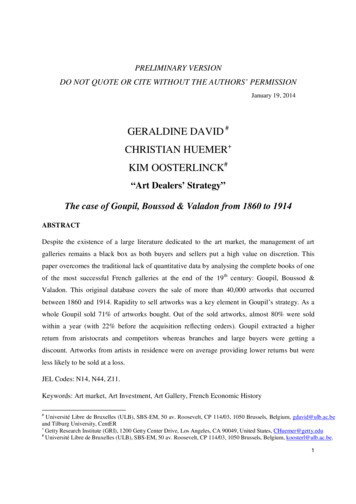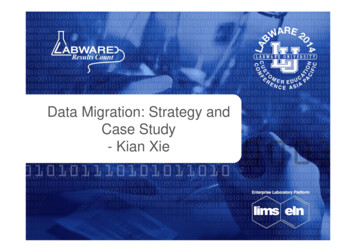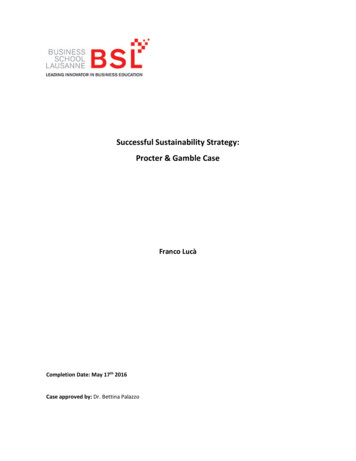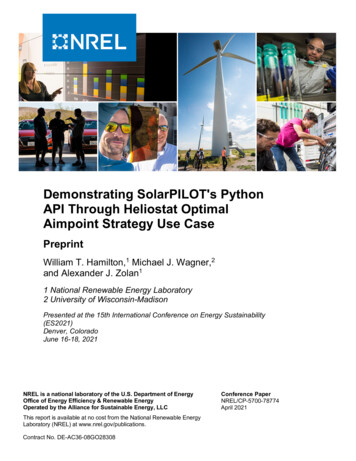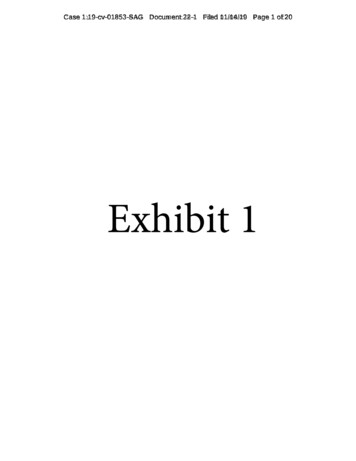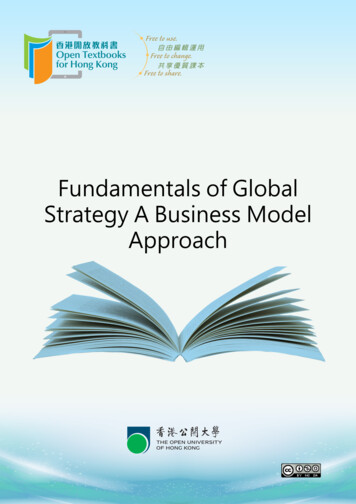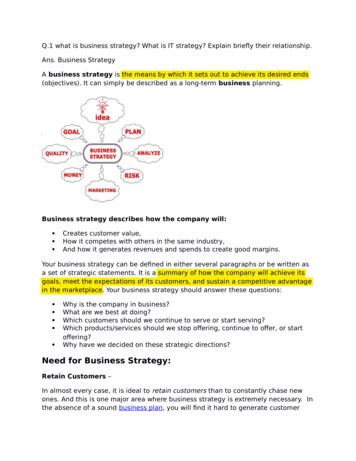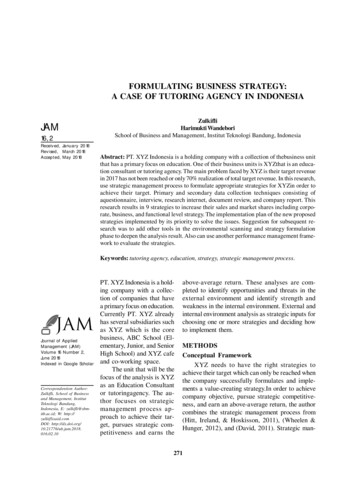
Transcription
Formulating Business Strategy: A Case of Turoring Agency in IndonesiaFORMULATING BUSINESS STRATEGY:A CASE OF TUTORING AGENCY IN INDONESIAJAM16, 2Received, January 2018Revised, March 2018Accepted, May 2018ZulkifliHarimukti WandeboriSchool of Business and Management, Institut Teknologi Bandung, IndonesiaAbstract: PT. XYZ Indonesia is a holding company with a collection of thebusiness unitthat has a primary focus on education. One of their business units is XYZthat is an education consultant or tutoring agency. The main problem faced by XYZ is their target revenuein 2017 has not been reached or only 70% realization of total target revenue. In this research,use strategic management process to formulate appropriate strategies for XYZin order toachieve their target. Primary and secondary data collection techniques consisting ofaquestionnaire, interview, research internet, document review, and company report. Thisresearch results in 9 strategies to increase their sales and market shares including corporate, business, and functional level strategy. The implementation plan of the new proposedstrategies implemented by its priority to solve the issues. Suggestion for subsequent research was to add other tools in the environmental scanning and strategy formulationphase to deepen the analysis result. Also can use another performance management framework to evaluate the strategies.Keywords: tutoring agency, education, strategy, strategic management process.Journal of AppliedManagement (JAM)Volume 16 Number 2,June 2018Indexed in Google ScholarCorrespondention Author:Zulkifli, School of Businessand Management, InstitutTeknologi Bandung,Indonesia, E: zulkifli@sbmitb.ac.id; W: http://zulkiflisaid.comDOI: . XYZ Indonesia is a holding company with a collection of companies that havea primary focus on education.Currently PT. XYZ alreadyhas several subsidiaries suchas XYZ which is the corebusiness, ABC School (Elementary, Junior, and SeniorHigh School) and XYZ cafeand co-working space.The unit that will be thefocus of the analysis is XYZas an Education Consultantor tutoringagency. The author focuses on strategicmanagement process approach to achieve their target, pursues strategic competitiveness and earns theDIKTI ACCREDITED SK NO. 36a/E/KPT/2016above-average return. These analyses are completed to identify opportunities and threats in theexternal environment and identify strength andweakness in the internal environment. External andinternal environment analysis as strategic inputs forchoosing one or more strategies and deciding howto implement them.METHODSConceptual FrameworkXYZ needs to have the right strategies toachieve their target which can only be reached whenthe company successfully formulates and implements a value-creating strategy.In order to achievecompany objective, pursue strategic competitiveness, and earn an above-average return, the authorcombines the strategic management process from(Hitt, Ireland, & Hoskisson, 2011), (Wheelen &Hunger, 2012), and (David, 2011). Strategic man-271ISSN: 1693-5241271
Zulkifli, Harimukti Wandeboriagement process is a process of managerial decisions and actions that determine the long-run performance of a corporation (Wheelen & Hunger,2012). Figure 1shows the step by step of strategicmanagement process that consists of environmental scanning, strategy formulation, strategy implementation, and strategy evaluation.Strategic Management ProcessEnvironmental ScanningPhaseFind appropriate strategies for Edulab toincrease sales and market share as therequirements to achieve their target General EnvironmentIndustry EnvironmentCompetitor EnvironmentCostumer SatisfactionBusiness ModelCanvas ResourcesCapabilitiesCore CompetenciesValue Chain StrategyFigure 1 Conceptual Framework of Strategic Management ProcessThe environmental scanning is the first step instrategic management process consists of externalenvironment analysis, internal environment analysis, and business model canvas. Furthermore, themost important factors from this analysis that influenced company business will be summarized inSWOT.The second step is strategy formulation, oftenreferred to as strategic planning or long-range plan272JOURNAL OF APPLIED MANAGEMENTning, and is concerned with developing acorporation’s missions, objectives, strategies, andpolicies. It begins with situation analysis: the process of finding a strategic fit between external opportunities and internal strengths while workingaround external threats and internal weaknesses.The third step is strategy implementation showsthe total of activities and choices required for theexecution of a strategic plan. This process put theVOLUME 16NUMBER 2JUNE 2018
Formulating Business Strategy: A Case of Turoring Agency in Indonesiaobjective, strategies, and policies to an action bydeveloping program, budget, and procedure.The last step is strategy evaluation. The evaluation ensures that a company is achieving what itset out to accomplish. It compares performance withdesired results and provides the feedback necessary for management to evaluate results and takecorrective action, as needed.METHOD OF DATA COLLECTIONAfter defining the problems and research objectives, the authoruses several methodologies inconducting this research, as the purpose of this research is to identify internal and external environments that affect business performance in order tosolve XYZ’s problem and determine the suitablestrategies, implementation, and evaluation for XYZ.Based on the purpose, this research included inapplied research because this research aimed toobtain information that could be used to solve problems in the organization. Based on methodology type,this research included in caseof study research because it was done in a particular organization andaimed to analyze and interpret the uniqueness ofthe individual and situation in the organization.Primary and secondary data analysis are conducted in this research through several sources andtools as a source of data. Secondary data obtainedfrom literature studies using books, researching theinternet, Badan Pusat Statistik (BPS), Kemendikbudpublication, and company reports. Also,theauthoruses secondary data from an employeesurvey conducted by XYZ via an online questionnaire. The sample unit is XYZ’s employee withsample size 181 employee from 221 total employees per 1 October 2017. The sample employee consists of 91 teachers, 63 branch management, and27 central management.In order to complement secondary data, mixedresearch approaches are also used by the author tocollect primary data by using both of qualitative andquantitative approach. When collecting primarydata, author use survey research approaches throughinstrument questionnaire and interview. Questionnaire instrument used to determine the customersatisfaction and interview as an instrument to gatherDIKTI ACCREDITED SK NO. 36a/E/KPT/2016information about the internal situation in the company by asking the employee.For customer satisfaction survey throughaquestionnaire, the population is the total number ofXYZ student. They are finite and consists of 3,402students. For asample, theauthoruses nonprobabilityconvenience sampling to select the easiest population members from which to obtain information because they are willing and available to be studied.The sample unit is XYZ students. The sample sizeis 150 students. To determine the sample size,theauthorusessolving formula with a margin of error 8%.Which mean the number of samples neededis:n N3402 149.5 150 students1 Ne 2 3402(0.08) 2n samplesizeN Populatione margin of errorEnvironmental Scanning or Business SituationAnalysisThe first step in strategic management processis environmental scanning or also known as business situation analysis. This phaseconsists of external environment, internal environment, businessmodel canvas, and summarized in SWOT analysis.The external analysis consists of general environments, industrial environments, competitor analysis,and customer satisfaction analysis. For internalanalysis, an author uses resource-based view andvalue chain analysis.The general environment is composed of dimension in the broader society that influences anindustry and the firms within it. Below Table 1.General Environment analysis summary that mightimpact education industry.An industry’s profit potential is a function ofPorter five forces of competition: the threats posedby new entrants, the power of suppliers, the powerof buyers, product substitutes, and the intensity ofrivalry among competitors. Below Table 2. Five porter analysis of education consultant industry. 1 meaning strongly disagree and 5 meaning strongly agree.ISSN: 1693-5241273
Zulkifli, Harimukti WandeboriTable 1 General Environment analysis summaryFactorsDescriptionPolitical- Potential regulation of UN will be abolished in the year of 2017 - Admission regulation of newstudent at state universitiesimpacting competition for the entrance exam to a state university isgetting higher- The population of Indonesia increases 3 million every year- Provinces that has the highestnumber of high school student- Low B.I 7 day repo rate around 4.5%- A stable inflation rate that measured by consumer priceindex.- The province with high growth GRDP per capita- Provinces that have a high amount of tutoring institution- Distribution of uneven tutoring institution- The province with high human development index (HDI)- School participation rate from Highschool and college- Establishment of ASEAN economic society (AEC) in 2015- Technology changes rapidly- Technology that can change teaching and learning balTechnological(Source: author analysis)Table 2 Five porter analysis of education consultant industryScaleForces123The threat of New EntrantsHigh economies of scaleHigh product differentiationHigh capital requirementHigh customer switching costLack of support from the governmentConclusion45ModerateBargaining Power of SuppliersFew numbers of suppliersThe high cost of switching to alternative materialsThe importance of supplier products to the buyerSuppliers have more than one revenue streamLowBargaining Power of BuyersFew switching costs to move to another brandHigh price sensitivityA few buyersHigh undifferentiated productsModerateThe threat of Substitute ProductsNumerous number of substitute productsAttractive price-performance trade-off productsLow switching cost to substituteHighRivalry Among Competing FirmsNumerous number of equal competitorHigh barriers to exitSlow industry growthHigh(Source: Author analysis)274JOURNAL OF APPLIED MANAGEMENTVOLUME 16NUMBER 2JUNE 2018
Formulating Business Strategy: A Case of Turoring Agency in IndonesiaThere are many education consultants that canbe chosen by the customers. It depends on the geographical situation, business type, products, marketing, price, and the segment can be used to analyzethe competitor. Although there are lots of institutions offering the education consultancy, there areseveral institutions that almost similar with XYZ.They are Sony Sugema College (SSC), GaneshaOperation (GO), and Neutron.In order to gauge the satisfaction of the customer with the XYZ performance, the author did asurvey for the students. The method to measurethe customer satisfaction is used SERVQUAL fivedimensions (Zeithhamal, Parasuraman, & Berry,2009). Overall the customer satisfaction index is80%. Below the Table 3. XYZ customer satisfaction measurement result.Table 3 XYZ customer satisfaction measurement resultKeyStatementsTangibleThe builing and the XYZ room look attractive and comfortableXYZ has facilities that support teaching and learning processStaff and faculty are attractiveRelia-bility Services provided in accordance with the promisedMaterials taught in accordance with the curriculumThe time of execution of learning in accordance with theschedule formedRespon-sive Staff and teachers are always quick to help you when you need helpStaff and teachers tell you when they will help youStaff and teachers apologize when making mistakesAssur-ance Staff and teachers are friendly and courteousThe teacher has knowledge of the material he teachersThe cost you pay for guidance is proportional to what youget in XYZEmpa-thy Staff and faculty can be reached easilyStaff and teachers can communicate wellStaff and teachers understand your needsTotalx 0.730.940.8971%76%85%79%80%(Source: author analysis)Some of a firm’s resources are tangible whileothers are intangible and capabilities exist when resources have been purposely integrated to achievea specific task or set of tasks. Resourcesand capa-bilities that are valuable (V), rare (R), costly to imitate (I), and non-substitutable (N) are asource ofcompetitive advantage.Below Table 4. XYZ’s competitive advantage analysis.Table 4 XYZ’s competitive advantage analysisResources or CapabilitiesTangible ResourcesV RINComp. ConsequenceFinancialResources Comp. ParityComp. ParityComp. ParityComp. ParityLiquidityActivityDebtProfitabilityDIKTI ACCREDITED SK NO. 36a/E/KPT/2016 ISSN: 1693-5241275
Zulkifli, Harimukti WandeboriResources or CapabilitiesTangible ResourcesV RINComp. ConsequenceOrganizational resourcesStrategic planning effectivenessExcellence control systemExcellence evaluation systemPartnership Comp. ParityComp. ParityComp. ParityComp. ParityPhysical resourcesModern classClass facilityBuilding location Comp. ParityComp. ParityComp. ParitySharing knowledgeTrustManagerial capabilitiesOrganization routines Comp. ParityTemp. Comp. Adv.Comp. ParityComp. ParityIn
FORMULATING BUSINESS STRATEGY: A CASE OF TUTORING AGENCY IN INDONESIA Zulkifli Harimukti Wandebori School of Business and Management, Institut Teknologi Bandung, Indonesia Abstract: PT. XYZ Indonesia is a holding company with a collection of thebusiness unit that has a primary focus on education. One of their business units is XYZthat is an educa-tion consultant or tutoring
